
The common sunflower is a species of large annual forb of the genus Helianthus. It is commonly grown as a crop for its edible oily seeds. Apart from cooking oil production, it is also used as livestock forage, as bird food, in some industrial applications, and as an ornamental in domestic gardens. Wild H. annuus is a widely branched annual plant with many flower heads. The domestic sunflower, however, often possesses only a single large inflorescence atop an unbranched stem.

Helianthus is a genus comprising about 70 species of annual and perennial flowering plants in the daisy family Asteraceae commonly known as sunflowers. Except for three South American species, the species of Helianthus are native to North America and Central America. The best-known species is the common sunflower. This and other species, notably Jerusalem artichoke, are cultivated in temperate regions and some tropical regions, as food crops for humans, cattle, and poultry, and as ornamental plants. The species H. annuus typically grows during the summer and into early fall, with the peak growth season being mid-summer.

Verbesina, many species of which have crownbeard as part of their common names, is a genus of flowering plants, in the family Asteraceae. It is a large genus of about 350 species.
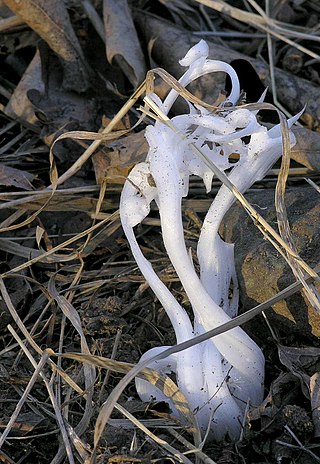
A frost flower or ice flower is formed when thin layers of ice are extruded from long-stemmed plants in autumn or early winter. The thin layers of ice are often formed into exquisite patterns, curling into "petals" which resemble flowers.

Cornus alternifolia is a species of flowering plant in the dogwood family Cornaceae, native to eastern North America, from Newfoundland west to southern Manitoba and Minnesota, and south to northern Florida and Mississippi. It is rare in the southern United States. It is commonly known as green osier, alternate-leaved dogwood, and pagoda dogwood.

Gracillariidae is an important family of insects in the order Lepidoptera and the principal family of leaf miners that includes several economic, horticultural or recently invasive pest species such as the horse-chestnut leaf miner, Cameraria ohridella.
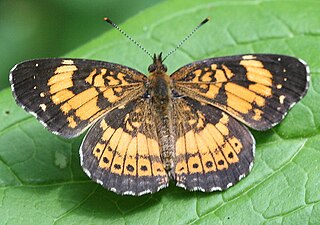
Chlosyne nycteis, the silvery checkerspot, is a species of Nymphalinae butterfly that occurs in North America. It is listed as a species of special concern in Connecticut and Maine, and is believed extirpated in Connecticut, Massachusetts, and New Hampshire.

Chlosyne lacinia, the bordered patch or sunflower patch, is a North and South American butterfly in the family Nymphalidae.
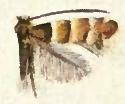
Chrysaster ostensackenella is a moth of the family Gracillariidae. It is known from Ontario, Québec and Nova Scotia in Canada, and the United States. It has also been recorded in 2015 from China and in 2017 from Korea, and in 2022 from Central Italy.
Cameraria magnisignata is a moth of the family Gracillariidae. It is known from Delhi, India.

Cremastobombycia grindeliella is a moth of the family Gracillariidae. It is known from California, United States.

Cremastobombycia solidaginis is a moth of the family Gracillariidae. It is known from Ontario and Quebec in Canada, and Florida, Texas, Georgia, Kentucky, Maine, Maryland, Massachusetts, Connecticut and Michigan in the United States.
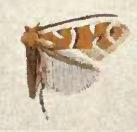
Cremastobombycia ambrosiaeella is a moth of the family Gracillariidae. It is known from Ontario and Quebec Canada, and Illinois, Kentucky, Texas, Maine and New York in the United States.

Cremastobombycia verbesinella is a moth of the family Gracillariidae. It is known from Florida, United States.
Caloptilia cornusella is a moth of the family Gracillariidae. It is known from Canada and the United States.
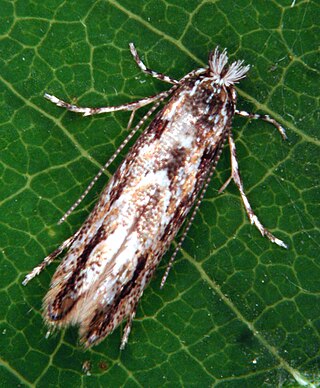
Lithocolletinae is a subfamily of insects in the moth family Gracillariidae. It is distributed worldwide, with most species in temperate regions.
Ironweed or iron weed may refer to:

Elephantopus carolinianus, with the common names Carolina elephantsfoot or leafy elephant's foot, is a species of flowering plant in the Asteraceae family. It is native to the south-central and southeastern United States.

Verbesina occidentalis is a flowering plant in the family Asteraceae. The common names for Verbesina occidentalis are yellow crownbeard and stick weed. Verbesina occidentalis is often considered a weedy plant of disturbed areas, due its presence in managed agricultural areas such as hayfields.

Verbesina helianthoides, commonly called yellow crownbeard or gravelweed, is a species of flowering plant in the family Asteraceae. It is native to the United States, where it is primarily found in the Upper South and South Central areas. Its natural habitat is in communities that receive ample sunlight, such as open woodlands, prairies, and glades.











